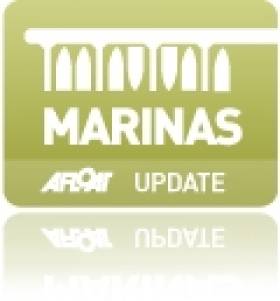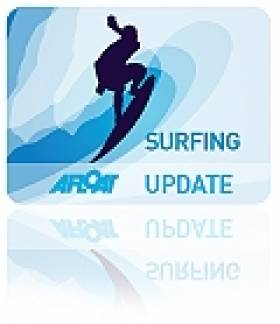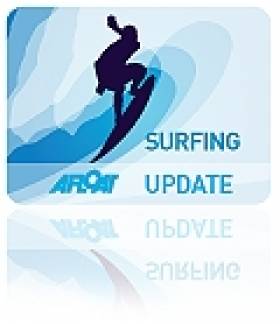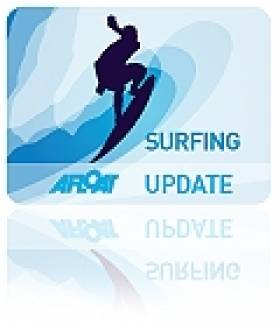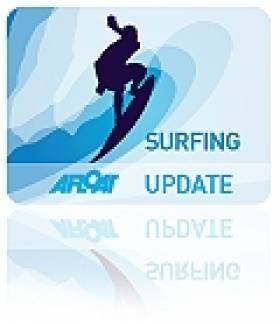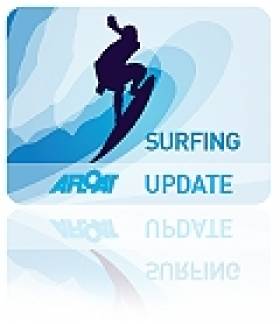Displaying items by tag: mullaghmore
Mullaghmore Pontoon. Yacht & Boat Berths in Sligo
Immediately inside Mullaghmore harbour in Donegal Bay is a new 20–metre pontoon provided primarily for embarking and disembarking and it is suitable for a range of plesure craft.
Spectacular Winter Surfing Captured On Video At Home And Abroad
#Surfing - Iceland, of all places, may not be known as a surfing hot-spot - but Irish wave rider Eoin McCarthy Deering has made something of the freezing swell, as the video above demonstrates.
The clip, via IrishCentral, was captured using one of the now ubiquitous GoPro portable HD cameras that enable extreme sports enthusiasts to record footage right from the centre of the action.
Closer to home, Epic TV reports on yet more incredible sessions at Mullaghmore Head and Aileens, this time by visiting surf pros Kohl Christiansen and Aritz Aranburu - see the videos below.
Christiansen took on the giant waves off Sligo - which are featured once again among the nominees for the Billabong XXL Big Wave Awards - while Aranburu headed to Clare with British rider Tom Lowe for a run at the famed surf break.
Kohl Christiansen at Mullaghmore Part 1:
Kohl Christiansen at Mullaghmore Part 2:
Aritz Aranburu at Aileens:
Surfing Ireland's 'Emerald Slabs' Caught On Video
#Surfing - Check out this stunning video of Portuguese surf pro Nic Von Rupp who cancelled his winter trip to Hawaii last week to take on what Surfer magazine calls 'Ireland's Emerald Slabs'.
Towing out to the storm-fuelled swells of Mullaghmore, Von Rupp shows just how it's done as the world's big wave surfing elite flocked to Sligo for the Billabong Tow-In Session.
Big Waves Come to Mullaghmore After Long Wait
#Surfing - Some of the world's top big wave surfing talent enjoyed the 'day that almost never was' at Mullaghmore in Sligo on Sunday.
As the video above shows, competitors in the long-delayed Billabong Tow-In Session finally got a chance to prove their mettle after two amber alerts in a week for the international event, pushed back from last year after a calm storm season.
Confidence was high as the storm front that has been battering Ireland for the past two days made its way across the Atlantic, bringing with it the giant swells needed to green-light the action.
Big wave surfers being secretive sorts, due to the dangerous nature of offshore tow-in surfing and their determination to keep their favourite spots 'just for them', we don't yet have results of the action, or even confirmation that the waves were big enough to count!
But what we do know is that the likes of Billabong XXL 2013 Ride of the Year nominee Peter Conroy were present and ready to tackle the colossal walls of water Mother Nature was set to provide.
Meanwhile, Met Eireann warns that gale force winds are expected to continue today (29 January) with southwesterly gusts of up to 110 km/h possible. Those in coastal areas have been warned to exercise caution.
Surfers On Amber Alert for Third Annual Tow-In Session
#Surfing - Some of the world’s best big wave surfers were last week hurriedly making their way to Ireland to compete in the third annual Billabong Tow-In Session at Mullaghmore in Co Sligo.
Event organisers gave the amber light for the one-day event on the strength of a giant swell that was forecast to reach Mullaghmore this past Monday.
As previously reported on Afloat.ie, the waiting period for the event commenced in November 2012 and finishes on 1 March this year. Organisers only need one day of giant waves to stage the event.
The huge North Atlantic swell headed Ireland’s way looked like providing surf big enough to stage the event but, most importantly, the forecast giant waves were expected to be accompanied by light and favourable winds.
Last year’s event was cancelled because waves in excess of 20 feet in height, with favourable winds, didn’t arrive during the four-month waiting period. But contest director Paul O’Kane said on the current forecasting models it looked like there would be clean and perfect 20-foot waves at Mullaghmore on Monday.
“For a big wave surfing contest such as this that’s about the minimum size we need to run the event,” he said. “But because the ocean conditions will be so clean and perfect on Monday that’s why we have decided to go to amber alert... This will give all the Irish competitors and those coming from overseas enough time to get here and be well organised with their equipment.
For safety reasons the event is restricted to invitees only. Because lives are at stake, only those surfers with recognised big wave experience have been invited to compete. Competitors are also expected to be well versed and qualified in the all necessary rescue and water safety procedures.
Mullaghmore, along with Aileen’s at the Cliffs of Moher in Co Clare, is fast gaining a reputation as one of the most fearsome and challenging big wave locations in the world.
Irish surfers competing in the event are Richie Fitzgerald and Peter Craig (Donegal), Dave Lavelle and Mikee Hamilton (Sligo), Peter Conroy and Ollie O’Flaherty (Clare), Hugh Galloway (Galway) and Al Mennie (Antrim). The international field this year also includes competitors from Ireland, Hawaii, USA, Great Britain, France, Spain, Germany, Tahiti and South Africa.
The event is sanctioned by the Irish Surf Rescue Club and the Irish Surfing Association. Here's hoping we learn soon if the day was a roaring success or a wipeout!
Surfers On Standby for Third Big Wave Tow-in Session
#SURFING - Some of the world's best big wave surfing stars are making their way to Ireland again this winter to compete in the third annual Billabong Tow-In Session.
The waiting period for the event started on November 1 and finishes on March 1. Organisers only need one day of giant waves at Mullaghmore in Co Sligo to stage the event.
And as reported yesterday on Afloat.ie, this weekend could produce some big results as growing swells in the Atlantic combine with southerly winds.
Last year's event was cancelled because the required waves in excess of 20 feet failed to arrive during the four-month waiting period.
The inaugural event in 2010, however, saw competitors taking on 20-30 foot waves at Mullaghmore, a break that is fast gaining a reputation as one of the most fearsome and best big wave locations in the world.
"Mullaghmore is an incredible wave, one of the heaviest I've surfed and one that holds unlimited potential for giant waves," said the 2010 winner Benjamin Sanchis from France.
Sanchis and his partner Eric Rebiere have been invited back to defend their title.
Along with the defending champions competitors from Ireland, Hawaii, USA, Great Britain, France, Spain, Germany, Tahiti and South Africa have all been invited.
The runner-up pair from the inaugural event, Peter Conroy (Co Clare) and Glyn Ovens (UK), are among several Irish teams set to challenge the overseas surfers in their home country.
"Mullaghmore is impressive with its grassy headland acting as natural amphitheatre for spectators to watch the event," said Conroy, "but it's a scary place when the surf is big. There's lots water swirling around and surging up from the underwater reef ledges.
"Hopefully this year's event will get great waves and we will all return safely to shore."
Because lives are at stake, only those surfers with recognised big wave experience are invited to compete. Competitors are also expected to be well versed and qualified in all the necessary rescue and water safety procedures.
The event is sanctioned by the Irish Surf Rescue Club and the Irish Surfing Association.
Surfing is Ireland's 'Best Kept Secret' No More
#SURFING - Ireland can no longer claim to be the surfing world's best kept secret, as the Irish Examiner reports, as thousands of waveriders of all skill levels now flock annually to the west and northwest coasts to sample the swell.
Indeed, Ireland is arguably the hottest place to be for surfing right now, and RTÉ Travel rounds up the best spots to hit the water around the coast - including some that might surprise you.
Bundoran is this country's surfing mecca, and for good reason. Recently making National Geographic's list of the world's top 20 surfing towns, the Co Donegal surf capital has spots for everyone from experts to beginners, and boasts a choice of 10 surf schools affiliated with the Irish Surfing Association.
Further down the coast is Sligo, renowned among the surfing elite for the giant rollers off Mullaghmore Head but also a great place for learners, especially at Strandhill and Enniscrone - although "big waves, clean waters and great surfing" are to be found anywhere along the coastline.
Mayo continues the trend, with Bertra in Clew Bay and Keel Strand in Achill standing out, while Clare is home to the famed waves at Lahinch - home turf for big wave surfer Ollie O'Flaherty.
Further along, Kerry and West Cork can boast of a number of top-class surfing destinations, including some stretches just perfect for absolute beginners.
But it doesn't end there, as even the southeast and east coasts can hold their own - as Tramore in Co Waterford and Brittas Bay in Co Wicklow can attest.
Best Ever Surfing Winter for Ferg and Tom
Surfing magazine MagicSeaweed recently caught up with waveriders Fergal Smith and Tom Lowe to get the lowdown on winter surfing on the Emerald Isle.
The pair describe how flat surf after last November's 'big freeze' gave way to a run of big waves from January to March. For UK pro Lowe in particular it was his best ever season - but also one that left him spent.
"The finisher for me was that Mully morning session [off Mullaghmore]," he told MagicSeaweed. "Ferg towed me into the best wave of my life that morning; sounds wet but I was drained emotionally and physically by it."
For 'Ferg' Smith, the highlight was the paddle session at the Pampa wave near Bundoran.
"I grew up surfing Pampa so I know the wave well but I have never surfed it as big and perfect at that," he said.
MagicSeaweed has more insights from Tom and Ferg HERE.
Giant Prowler Wave Location Remains Secret
According to a Press Association report one of the six-man team, Briton Andrew Cotton, first spotted it several years ago while on board an Irish Coast Guard helicopter after being rescued from a surf accident off Mullaghmore, Co Sligo.
Last night some west coast surfers told Afloat.ie the location is most likely off the Sligo coast, up to two kilometres offshore and close to an underwater reef.
The terrifying-looking wave, dubbed 'Prowlers', was reportedly up to 50ft high on Tuesday when the Irish, British, Australian and South African surfers ventured out. Photos of it appeared on the front page of the Irish Times yesterday.
The surf team included Bundoran's Richie Fitzgerald who says he had waited for five years for the type of conditions required to surf it and on Monday the waves were in the 40-50ft range. Conditions were perfect due to the massive swell generated by Hurricane Tomas.

